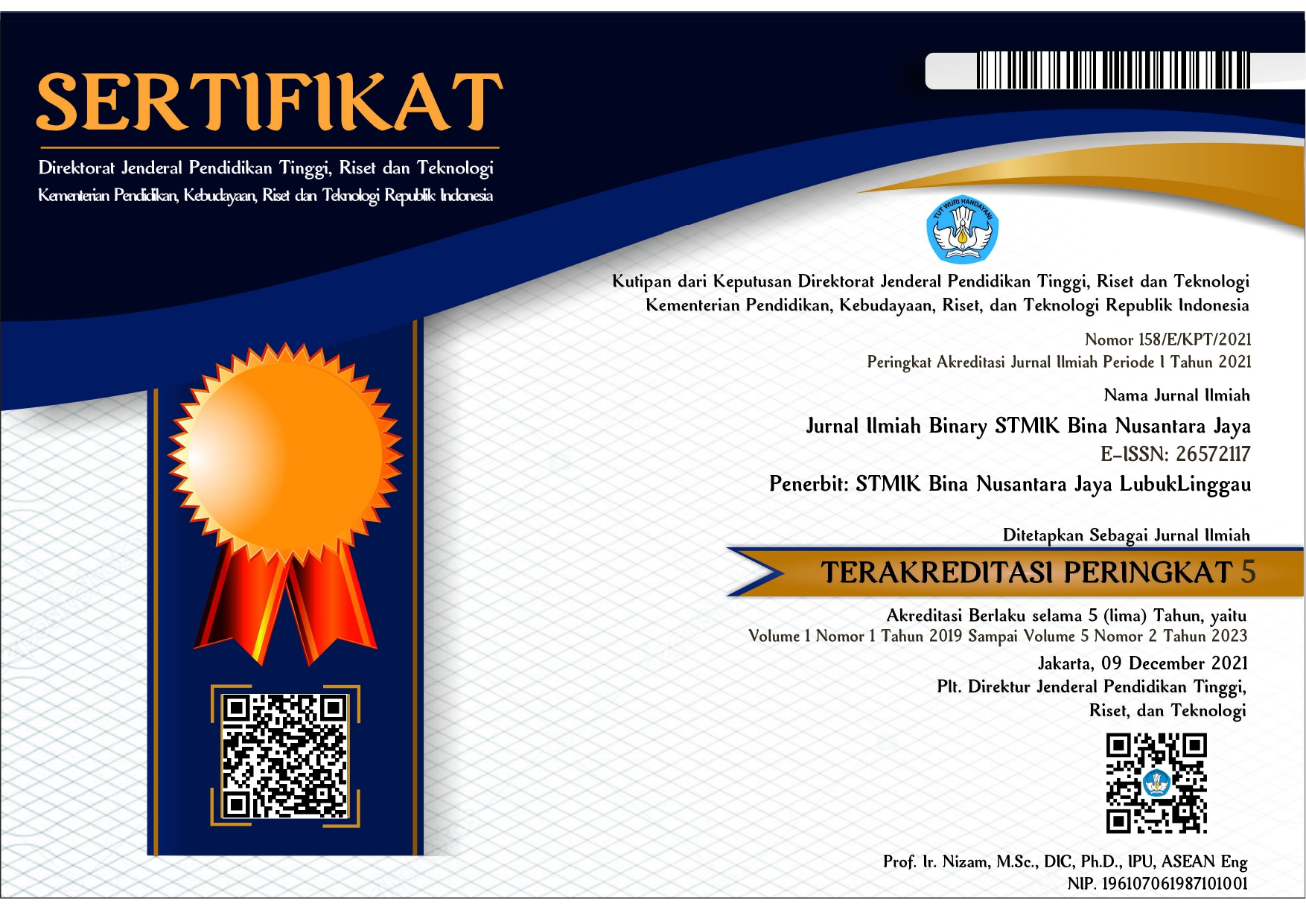Implementasi Metode Case Based Reasoning untuk Mendiagnosa Penyakit Lambung
Abstract
The more advanced times cause people to be busier and longer pay attention to their eating patterns. Irregular eating patterns and stress due to busyness can cause stomach disease, such as gastritis, gerd, and peptic ulcers. Complaints and symptoms of disease felt by people with gastric disease vary, so it is difficult to know the type of disease in his suffering. Most people only know what that gastric disease is called gastritis, whereas gastric disease is of various kind. Therefore, there needs to be an anlysis that can diagnose gastric disease. This study uses the Case Based Reasoning (CBR) method to diagnose gastric ailments, by looking for closeness or similarity between symptoms in old cases with symptoms in new cases. Criteria or symptoms used for the diagnosis process include pain in the pit of stomach, bloating, nausea, vomiting, lower chest pain, belching, feeling full quickly, and the stomach feels full. While gastric disease variables consist of gastritis, gerd, and peptic ulcers. The results showed that the calculation of the value closeness between new cases and old cases is close or similar, this shows that the Case Based Reasoning method can diagnose gastric disease well.
References
[2] Wikipedia, “Peptic Ulcer Disease.” .
[3] T. Sutojo, Kecerdasan Buatan. Yogyakarta: Andi Offset, 2011.
[4] D. A. Kusuma and C. Chairani, “Rancang Bangun Sistem Pakar Pendiagnosa Penyakit Paru-Paru Menggunakan Metode Case Based Reasoning,” J. Inform. dan Elektron., vol. 6, no. 2, pp. 57–62, 2015.
[5] E. Wahyudi and S. Hartati, “Case-Based Reasoning untuk Diagnosis Penyakit Jantung,” IJCCS (Indonesian J. Comput. Cybern. Syst., vol. 11, no. 1, p. 1, 2017.
[6] Minarni, I. Warman, and W. Handayani, “Case-Based Reasoning (CBR) pada Sistem Pakar Identifikasi Hama dan Penyakit Tanaman Singkong dalam Usaha Meningkatkan Produktivitas Tanaman Pangan,” J. TEKNOIF, vol. 5, no. 1, pp. 41–47, 2017.
[7] S. Kosasi, “Pembuatan Aplikasi Diagnosa Kerusakan Mesin Sepeda Motor Matic dengan Case-Based Reasoning,” Creat. Inf. Technol. J., vol. 2, no. 3, p. 192, 2015.
[8] S. Fidyaningsih, F. Agus, and S. Maharani, “SISTEM PAKAR DIAGNOSA PENYAKIT KUCING MENGGUNAKAN METODE CASE BASED REASONING,” Pros. Semin. Ilmu Komput. dan Teknol. Inf., vol. 1, pp. 113–119, 2016.
[9] Y. E. B. Mawartika and M. Guntur, “Aplikasi Sistem Pakar Pemilihan Makanan Berdasarkan Kebutuhan Gizi,” CogITo Smart J., vol. 7, no. 1, p. 96, 2021.
[10] R. Rosnelly, Sistem Pakar: Konsep dan Teori. Yogyakarta: Andi Offset, 2012.
[11] Marimin, Sistem Pendukung Pengambilan Keputusan dan Sistem Pakar. Bogor: IPB Press, 2017.
[12] Andriana, Sistem Penalaran Komputer Berbasis Kasus (Case Based Reasoning-CBR). Yogyakarta: Ardana Media, 2008.
13] F. O. S, J. Purwadi, and R. Delima, “Implementasi Case Based Reasoning Untuk Sistem Diagnosis Penyakit Anjing,” J. Inform., vol. 7, no. 2, pp. 155–162, 2012.
[14] M. Papuangan, P. Studi, T. Informatika, F. Teknik, and U. P. Morotai, “Penerapan Case Based Reasoning Untuk,” vol. 02, no. 1, 2018.
[15] S. Kusumadewi, Artificial Intelligent (Teknik dan Aplikasinya). Yogyakarta: Graha Ilmu, 2003.
[16] Sugiyono, Metode Penelitian Kuantitatif Kualitatif dan R&D. Bandung: Alfabeta, 2017.











